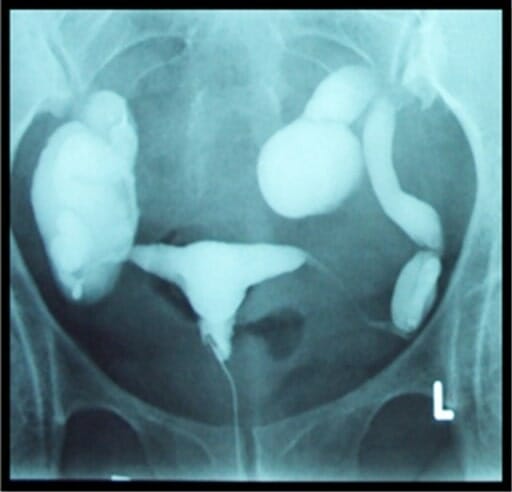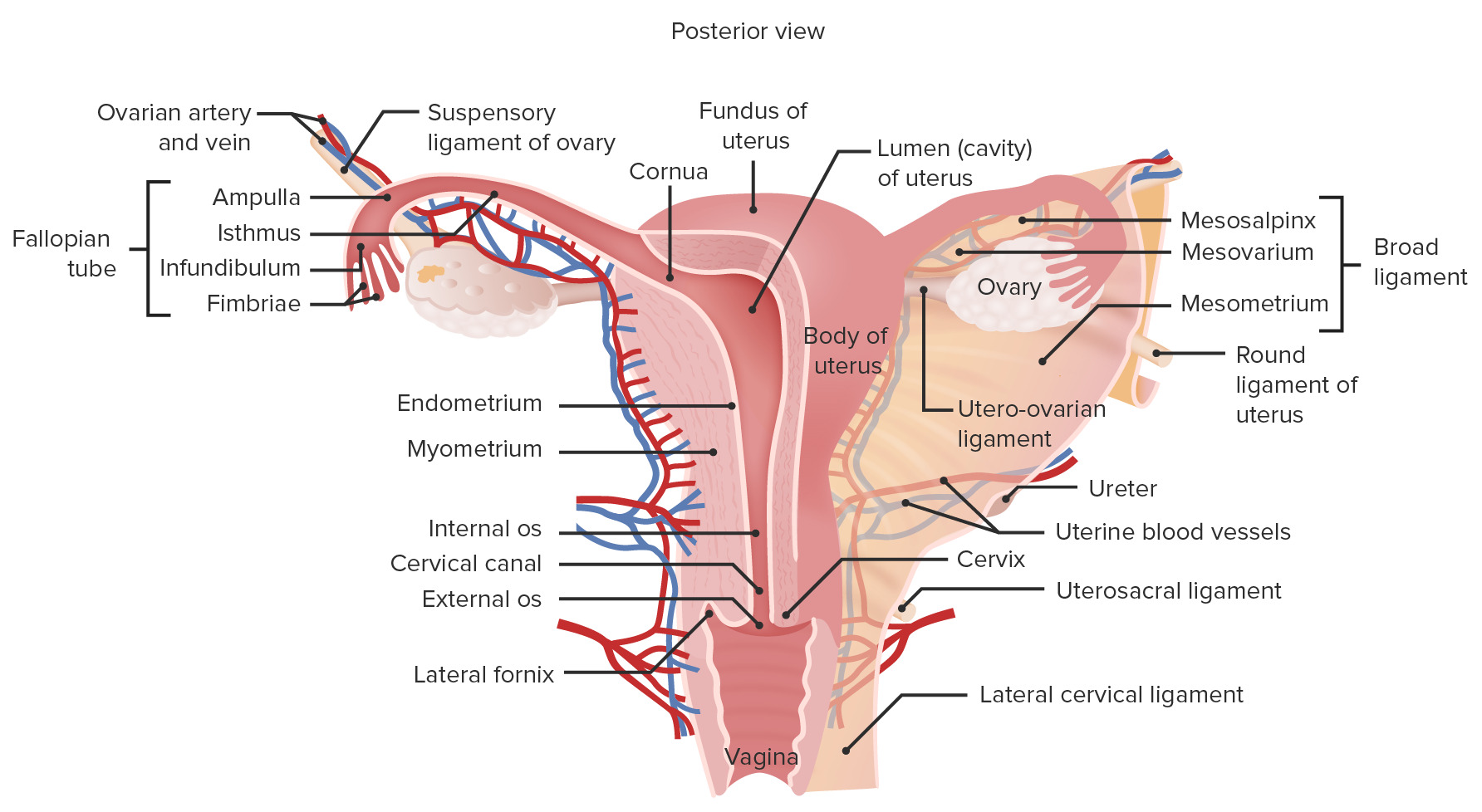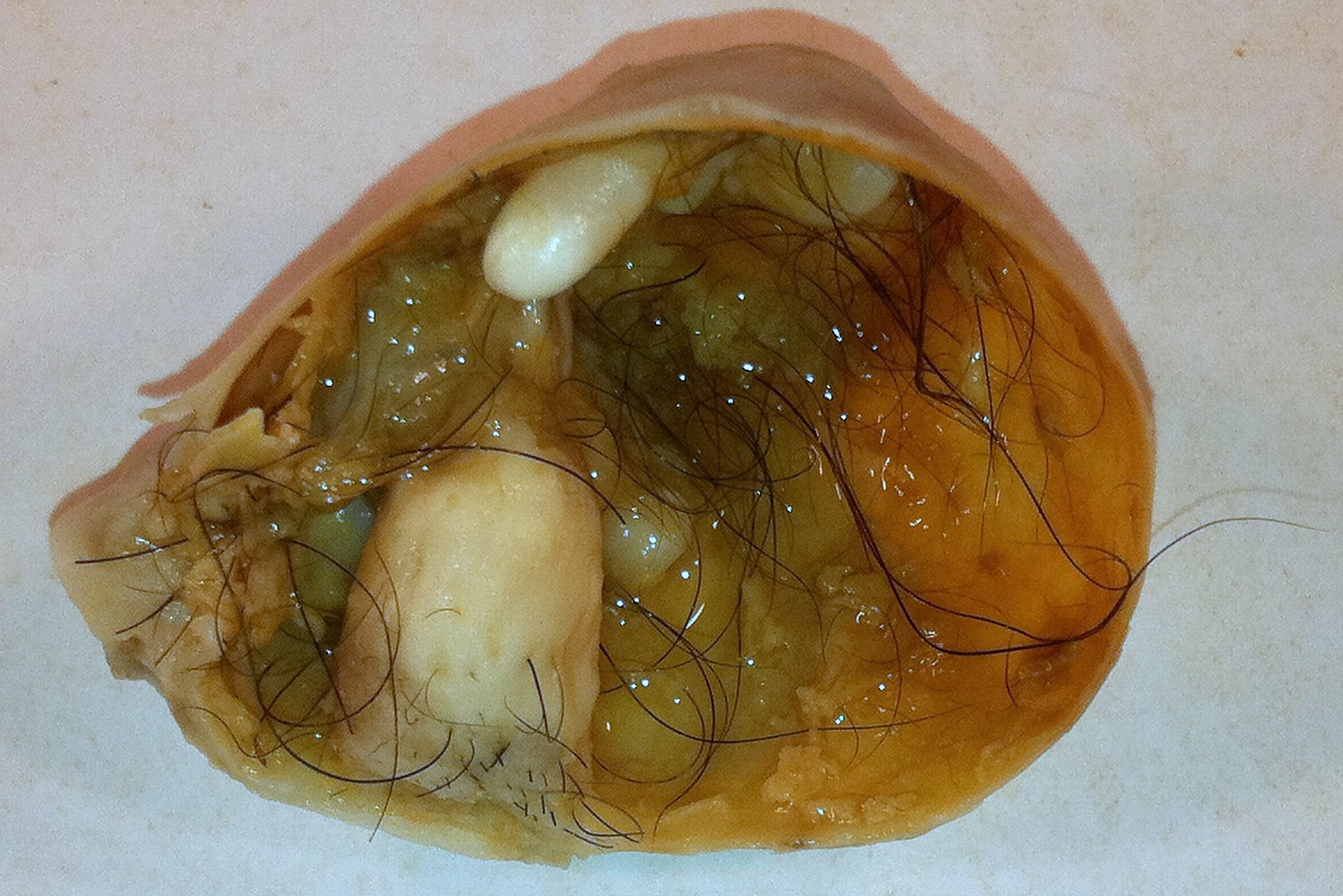Playlist
Show Playlist
Hide Playlist
Types of Ovarian Tumors: Epithelial Tumors
-
Slides Ovary Female Repro.pdf
-
Reference List Pathology.pdf
-
Download Lecture Overview
00:01 We’ll begin our organization. 00:03 Most of your ovarian tumors will be of surface epithelial tumors. 00:09 Ladies and gentlemen, this is where your focus should be. 00:15 We will talk about specific surface epithelial tumors. 00:17 I have divided this into tables coming up next. 00:20 Let’s take a look. 00:24 Overall, the topic is surface epithelial cell tumors. 00:29 Overall, the frequency of all of your ovarian tumors, 65-70%. 00:34 This is where your focus should be. 00:37 The proportion of malignant ovarian tumors, 90% of your malignant ovarian tumors are surface epithelial. 00:47 Age group: Early. 00:49 It could be 20 plus. 00:51 Now, the types. 00:52 Serous, mucinous, endometrioid. 00:56 Let me stop there. 00:57 Why? Because endometrioid sounds an awful lot like endometriosis. 01:03 Sounds a lot like endometritis and it sounds a lot like your endometrioma. 01:08 This is your ovarian tumor. 01:12 It’s called endometrioid tumor. 01:15 Would you tell me what the suffix -oid means? Similar to. 01:19 Leukomoid reaction. 01:22 Endometrioid. 01:23 Epithelioid. 01:25 Right? So here, we have -oid. 01:27 It looks like endometrium, but it is an ovarian tumor. 01:30 Of what family? Surface-derived. 01:34 If you have a surface tumor, how does it like to spread? Surface, likes to seed. 01:42 What does seed mean? It is going to spread to adjacent structures. 01:47 Your focus, by the way, with surface-derived epithelial tumor will be on serous, serous, serous. 01:54 Let’s begin. 01:57 We have 75% of ovarian tumors are surface derived. 02:00 Usually women greater than 20. 02:02 Divided into - we’ll be doing serous, mucinous and endometrioid. 02:07 We’re not going to go through every single one. 02:09 We’ll go through the high yield types of our surface. 02:13 Overall, remember frequency, 65-70%. 02:17 So we will be going through this methodically. 02:20 And I want to make sure that I drill home to you those important salient features. 02:29 The etiology, continuing forward, cystic lesions lined by tall, columnar, cilated epithelial cells filled with serous fluid. 02:38 This is the one that you want to pay attention to and know the histology quite well. 02:43 It’s a cystic lesion, tall, columnar, cilated. 02:47 Usually papillary, so therefore the serous type of epithelial tumor will be papillary. 02:54 Take a look at the P in papillary. 02:57 Take a look at the P in psammoma. 03:00 Psammoma bodies, the description that they’ll give is calcium deposition. 03:06 Okay? You must know what a psammoma body is. 03:09 It’s calcium deposition. 03:11 Also, psammoma bodies is not only found in serous cystadenocarcinoma. 03:18 It can also be found with meningioma. 03:20 It could be found in a couple of places. 03:24 If epithelium is benign, then called papillary serous cystadenoma. 03:30 If it’s malignant, you call it serous cystadenocarcinoma. 03:35 What we’re looking at here is a papillary serous cystadenoma. 03:39 You’ll notice the following that on the image, you’ll find exactly that which is papillary-like with finger-like projections. 03:47 And histologically, you’ll find it to be well-encapsulated because this is a common - Actually, this is the most common, benign, ovarian tumor. 03:56 How do you know it’s benign? Look at the name. 03:58 Cystedenoma. 04:00 And upon histologic examination, it will be well-encapsulated, well-differentiated. 04:05 Serous epithelial tumor, etiology. 04:07 Epithelium is malignant, then we’d call it serous cystadenocarcinoma. 04:12 You must know that usually, it will be bilateral ovaries. 04:16 It is important that you know how many ovaries will be affected. 04:19 Unilateral or bilateral. 04:21 In this case, bilateral. 04:22 Just to make sure that you have the big picture, we’re doing surface-derived epithelial tumors, under that, we’re focusing upon the most common benign surface epithelial tumor, the serous cystadenoma. 04:36 And the next would be the most common malignant surface epithelial tumor, which is a serous cystadenocarcinoma. 04:45 A lot of names sound alike. 04:47 I want to make sure that we’re very clear and deliberate as to what we’re describing. 04:51 Here, you have a papillary serous cystadenocarcinoma, extremely chaotic within the ovary. 04:58 And number two, on histologic examination, you will find extremely poor differentiation. 05:05 Highly malignant. 05:06 The term serous cystadenocarcinoma has been updated to type 1, or low-grade serous carcinoma, and type two, or high grade serous carcinoma. 05:15 Mucinous and endometrioid carcinomas, coming up next, are also described as type 1 which is low grade or type 2 which is high grade. 05:24 Our second type of surface-derived epithelial tumor, let’s call it mucinous epithelial tumor. 05:33 The term mucinous means exactly that. 05:35 Mucin. 05:36 Here, you’d have cystic lesion, but this time instead of it being tall, columnar, ciliated, these will be mucin-producing cells filled with mucus. 05:47 There you have it. 05:48 Everything that you need to know about mucinous, mucus cells filled with mucus. 05:52 But you’re still going to form a cyst. 05:55 Rare before puberty and after menopause, so therefore would be taking place in a female in the reproductive age. 06:04 I’ve mentioned earlier that you want to pay attention to how many of the ovaries have been affected. 06:09 If it is serous, then it will be both, bilateral. 06:14 However, if it’s mucinous, most likely, not bilateral. 06:19 It can present with - now, here’s a term here called pseudomyxoma peritonei. 06:24 In ovarian tumor with mucinous ascites, sometimes referred to as being your malignant ascites. 06:32 The term here is pseudomyxoma peritonei, All pseudomyxoma peritonei tumors arise from the appendix, or very rarely from neoplasms in the colon, pancreas, or urachus. Although they can be found on the ovary, they do not arise from the ovary. The term pseudomyxoma peritonei refers to a clinical syndrome with diffuse mucinous peritoneal involvement from a ruptured appendiceal lesion. 06:55 It is not a histologically-based term, and is not used in the staging or histologic classification of appendiceal nor ovarian neoplasms. 07:04 A mucinous cystadenoma looks quite different from that of papillary The papillary serous cystadenoma and cystadenocarcinoma would have more of that papillary, well-defined type of structure. 07:16 A mucinous looks more sponge-like. 07:18 It looks like it has cavitations. 07:20 It looks like there’s a lot more cysts. 07:21 And you would find a lot more mucus and mucus cells that are then producing your mucus upon histology. 07:29 Our discussion, two different types of surface-derived epithelial tumors. 07:35 Serous and mucinous.
About the Lecture
The lecture Types of Ovarian Tumors: Epithelial Tumors by Carlo Raj, MD is from the course Ovarian Diseases.
Included Quiz Questions
Which of the following is NOT one of the types of epithelial-derived ovarian tumors?
- Germ cell
- Serous
- Brenner
- Endometrioid
- Mucinous
Which statement describes a similarity between mucinous and serous ovarian tumors?
- They tend to occur among women at a similar age.
- They are usually benign.
- They are usually metastasic from a primary GI tumor.
- They may present with pseudomyxoma peritonei.
- They are usually bilateral.
What is pseudomyxoma peritonei?
- A rare malignant growth characterized by the progressive accumulation of mucinous tumor cells in the abdomen and pelvis
- Adenocarcinoma of the peritoneum without an obvious primary tumor but thought to originate from the ovaries
- A benign tumor of the abdomen containing mucous or gelatinous material
- The development of serous ascites associated with cancer cells
- Calcium deposits found in ovaries with malignancy
Which of the following statements about papillary serous cystadenoma is INCORRECT?
- It is the most common form of malignant ovarian tumor.
- Histologically, it contains psammoma bodies.
- It has cystic lesions lined by tall, columnar, ciliated epithelial cells and is filled with serous fluid.
- It is frequently bilateral.
- It is well-encapsulated and well-differentiated.
Customer reviews
5,0 of 5 stars
| 5 Stars |
|
5 |
| 4 Stars |
|
0 |
| 3 Stars |
|
0 |
| 2 Stars |
|
0 |
| 1 Star |
|
0 |






